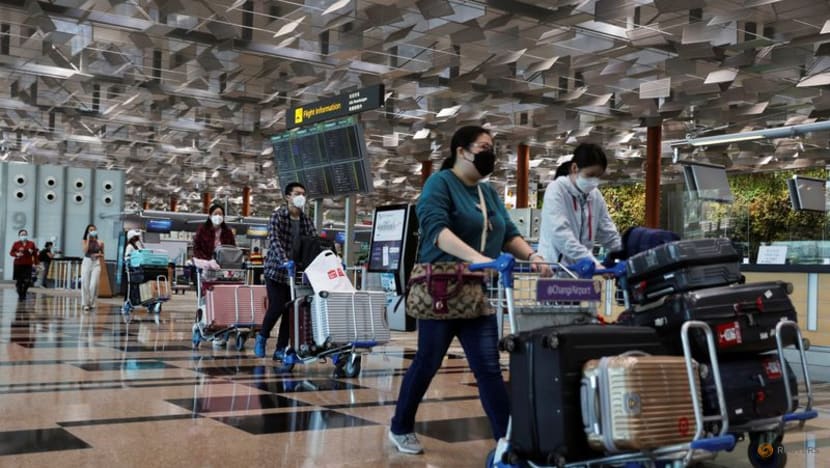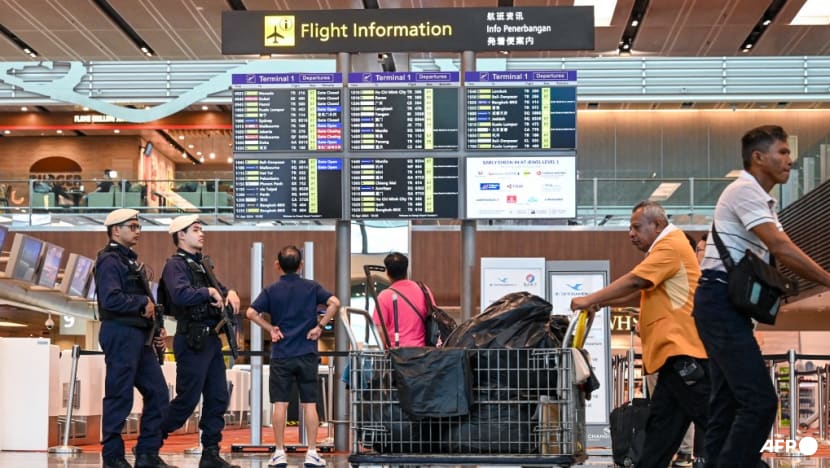Global tourism expected to surpass pre-pandemic levels, driven by pent-up demand: WEF index
Europe and Asia Pacific continue to have the most favourable conditions for tourism and travel development.

Travellers walk with their luggage at the Changi Airport in Singapore on March 30, 2022. (Photo: Reuters/Edgar Su)

This audio is generated by an AI tool.
The tourism sector is expected to bounce back this year, with global tourist arrivals set to surpass levels seen before the COVID-19 crisis, according to a report by the World Economic Forum (WEF) released on Tuesday (May 21).
The sector’s contribution to global gross domestic product (GDP) is also likely to return to pre-pandemic levels, driven by the lifting of travel restrictions and strong pent-up demand, the WEF’s travel and tourism development index said.
The biennial report, published in collaboration with the University of Surrey, analyses the travel and tourism sectors of 119 countries around a range of factors and policies.
Mr Francisco Betti, head of the global industries team at the WEF, said: “This year marks a turning point for the travel and tourism sector, which has the capacity to unlock growth and serve communities through economic and social transformation.”
TURNING POINT FOR SECTOR
Recovery since the pandemic has been uneven across different regions.
In general, the Europe and Asia-Pacific regions continue to have the most favourable conditions for tourism and travel development.
This is helped by conducive business environments, dynamic labour markets, open travel policies, and strong transport and tourism infrastructure, said the report.
The WEF index provides a benchmarking tool to guide governments, businesses and other organisations in their policies, practices and also investment strategies.
High-income economies continue to lead the list, with the United States, Spain and Japan topping the ranking again.
On Japan making the top three, Mr Andreas Hardeman, head of aerospace, aviation, travel and tourism industries at the WEF, said: “We know that the country has excellent ground and transport infrastructure. It's a very safe place to travel, and to do so very efficiently as well.”
The country has also become more price competitive due to a weaker currency, he told CNA’s East Asia Tonight on Tuesday.
“That means that travel and tourism in the country has also become increasingly affordable for outside visitors,” he added.
“Going forward, I would say that the tourism sector in Japan could probably benefit from a wider range of accommodation options, while also addressing the challenge of overcrowding.”
France, Australia, Germany, United Kingdom, China, Italy and Switzerland round off the top 10 economies on the index. Singapore came in 13th on the list.
When asked what key strategies China has implemented to boost its tourism sector, Mr Hardeman told CNA's Otelli Edwards that the country’s efforts in improving airport connectivity, digital infrastructure and safety have paid off.
While travel and tourism have enabled conditions in developing countries to improve, more is needed to close the gap with the high-income countries, the WEF urged. It added that one way to achieve this would be sustainably leveraging natural and cultural assets.

SECTOR FACING COMPLEX CHALLENGES
“This is an industry that accounts for 10 per cent of the global economy. It employs about 350 million people worldwide – that's more than the entire population of the United States,” said Mr Hardeman.
“Over the next 10 years, this is expected to become a US$15.5 trillion industry, accounting for almost 12 per cent of the global workforce.”
Despite the sector’s post-pandemic growth, the operating conditions have been challenging, from ongoing labour shortages in many countries to air route capacity not keeping up with climbing demand.
The supply and demand imbalance, combined with broad inflationary pressure, has led to reduced price competitiveness and service disruptions, said the report.
The international tourism sector still faces various complex risks including geopolitical uncertainties, economic fluctuations, inflation, and extreme weather.
Sustainability is another major issue, with a likely return to pre-pandemic emissions levels.
The report called on decision-makers to prioritise actions to address these concerns, including managing infrastructure development, leveraging tourism for nature conservation efforts, and investing in an inclusive and resilient workforce.
If managed well, the travel and tourism sector has the potential to emerge as a key contributor to the well-being and prosperity of communities worldwide, said the report.
Mr Hardeman noted that the sector's potential is “enormous”.
On the key investments needed to address current gaps, he said the answer will be different for each country.
“Broadly speaking, we see that high income economies score better than their peers in emerging and lower and middle income economies,” he added.
“What those countries have in common are things like high quality transportation and digital infrastructure, high levels of openness and access, for example when it comes to visa requirements, (as well as) high standards in business facilities, safety and security, and healthcare.”
















